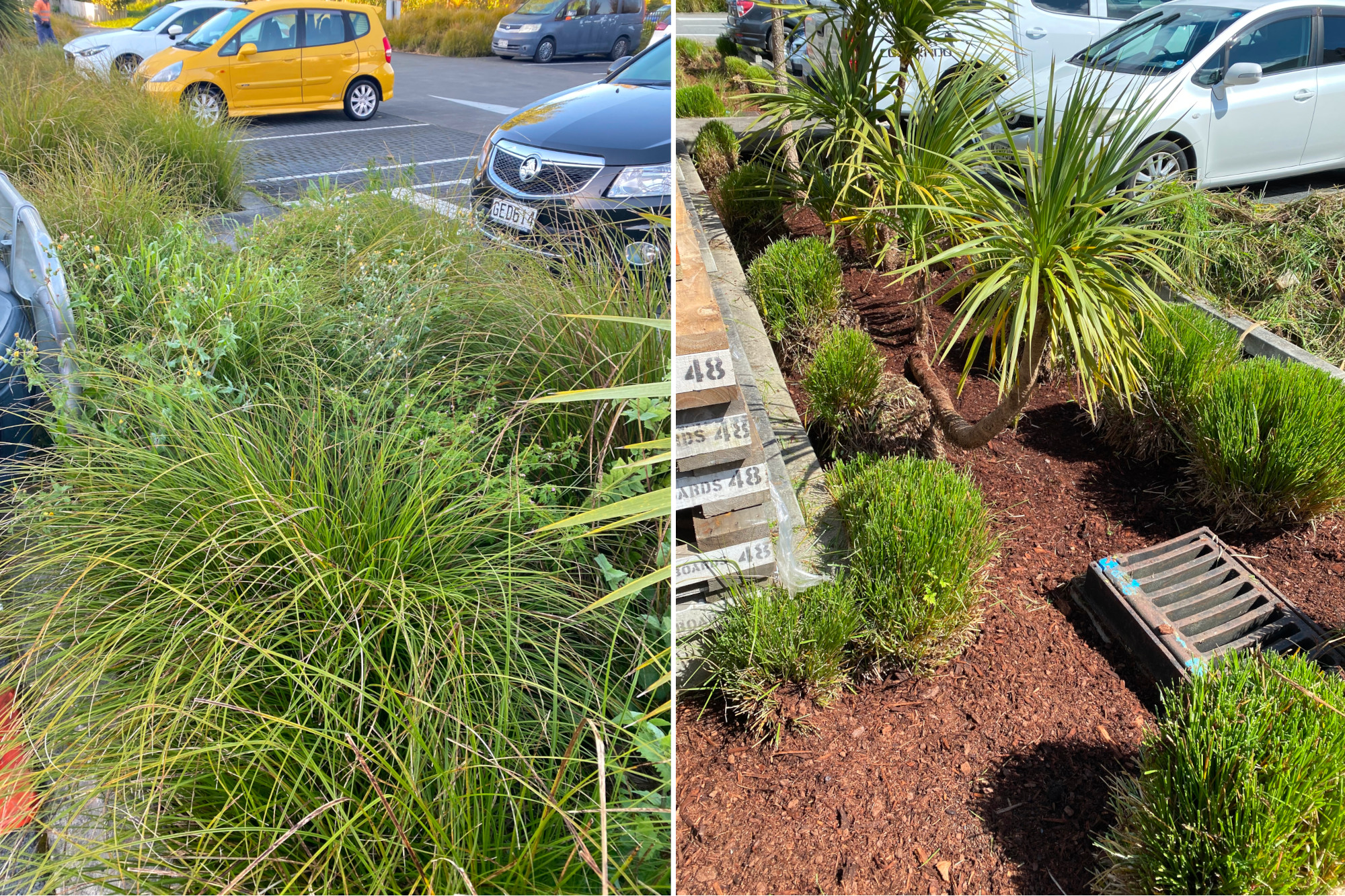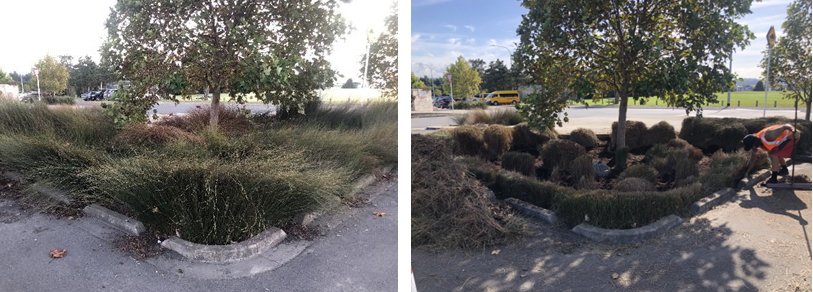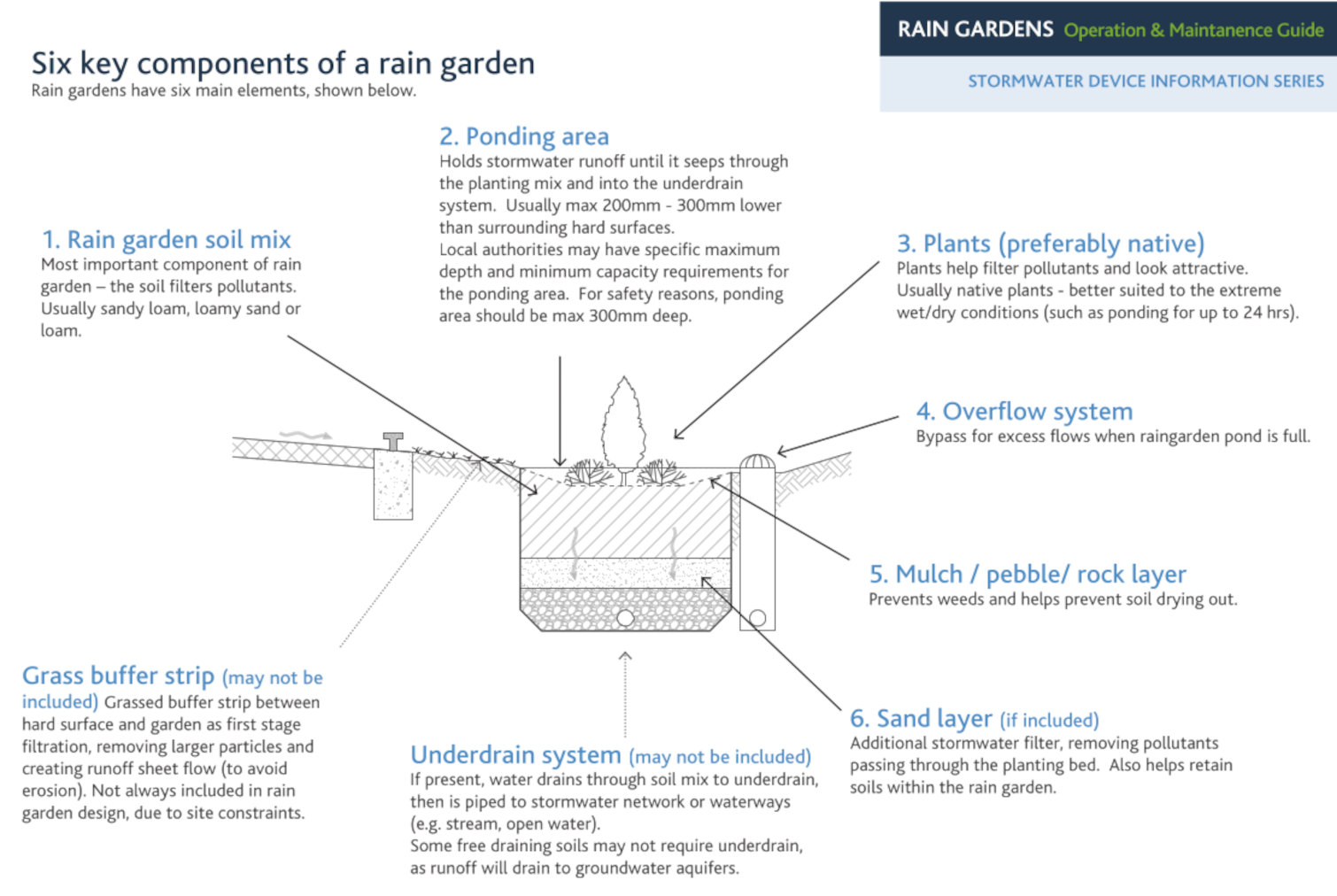
Raingardens are one of the stormwater treatment devices we service. Raingardens help remove pollutants and slow down stormwater flows. They recharge freshwater bodies and look attractive. They work as a filter, and they absorb contaminants.
Raingardens require regular maintenance to work properly. An important part of the raingarden annual inspection which is often overlooked is a permeability test. This can be checked after a heavy downfall or if the maintenance frequency does not fit in with a rainfall event, you can carry out the permeability test manually. Please don’t hesitate to call us if you think you have raingardens on your site, and we will come out and assess your raingarden requirements.
CLICK FOR A FREE QUOTE OR PHONE 0800 115 557

There are eight components of a Raingarden that should be regularly checked:
- The Rain Garden Soil Mix.
- The ponding area which is usually 200mm below the surrounding hard surfaces.
- Plants – preferably native.
- Overflow system.
- Mulch/pebble or rock layer – prevents weeds and prevents soil drying out.
- Sand layer
- Underdrain System – filters water drains into the underdrain and into the stormwater system.
- Grass buffer – between the hard surface and the garden and is the first stage of filtration.
Suggested Maintenance Schedule
| Following a storm | · Grass strip and paved area | · Remove rubbish, leaves, and debris from the drainage area. |
| · Ponding Area |
· Clear inflow points of sediment, rubbish, and leaves. · Check for erosion. · Test drainage of ponding area. · Top up soil and mulch as necessary. |
|
| · Mulch | · Mulch kept to 75mm. | |
| 3 – monthly | · Grass strip and paved area |
· If present mow to 50mm. Replant if necessary. · Remove rubbish, leaves, and debris. · Check soil and mulch level is below hard surface. |
| · Ponding Area |
· Clear inflow points of built-up sediment, rubbish, and leaves. · Check for erosion. |
|
| · Mulch | · Remove rubbish, leaves and other debris. | |
| · Plants |
· Water plants during dry months. · Check plant health and water as necessary. · Remove weeds. |
|
| Annually | · Ponding Area |
· Clear inflow points of sediment, rubbish, and leaves. · Check for erosion and gauging repair. · Check permeability. · If a crust is present on the soil, remove with a spade and rework using a rake. Top up where necessary. |
| · Rain garden soil mix | · Check the soil level is below the surrounding hard surface level and overflow grate. | |
| · Mulch layer | · Check the surface of mulch for a build-up of sediment. | |
| · Underdrain system |
· Use the inspection well to check underdrain is working properly. · Check Raingarden is raining freely using the drainage test. |

Troubleshooting
| Symptom | Possible Problems | Solution |
|
Stormwater run off is bypassing the rain garden |
Local earthworks increasing sediment load to rain garden, blocking rain garden outlets, or raising the surface level of garden. |
• Check surface of the rain garden is below the surrounding area. • Remove any sediments and debris from inflow areas and from the surface of the rain garden. • Protect rain garden from future construction sediments. |
| Rubbish and other debris blocking the inflow points to the rain garden. |
• Regularly remove rubbish, leaves, and any other debris from inflow points.
|
|
|
Rain garden is ponding for longer than 24 hours.
|
Incorrect blend of soil mix.
|
• Replace soil mix with the correct rain garden soil mix. • Do Ribbon test or percolation test to test soil mix is free draining |
| The soil within the garden compacted during construction or other activities. |
• Loosen the top 500mm soil by tilling or forking. • Discourage vehicle, pedestrian, and bicycle access to the rain garden. |
|
| Layer of fine sediment settled on the garden surface. |
• Remove fine sediment layer and turn over the top layer of rain garden soil mix. • Protect rain garden from surrounding sediment run off. |
|
|
Stormwater and/or mulch flowing off the rain garden.
|
Rain garden filled with too much mulch or soil. | • Remove excess mulch or soil so that surface of ponding area is approximately 200-300mm below the surrounding hard surfaces and overflow. |
| Overflows or discharge pipes clogged with sediments or debris. |
• Clear overflow and discharge pipes.
|
|
|
Planting or rain garden soil mix clogged.
|
• It may be necessary to remove some of the rain garden soil mix and replace with fresh rain garden soil mix. | |
| Sulphur smell coming from the rain garden. | Plants and soils lacking oxygen. Organic material rotting in the garden. |
• Inspect rain garden after rain event to check garden drains within 12 to 24 hours.
|
| The underdrain is clogged, and water is not properly draining out of the garden. | ||
| Erosion and gouging occurring within the rain garden |
Kerbs and other hard structures channelling stormwater flow. (Rain gardens require an even sheet flow of water to operate effectively.) Inflow points are too concentrated.
|
• Create openings in the kerb to increase number and width of run off points, or replace kerbing with a different design (e.g., kerbing slightly raised off the ground). • Increase kerb opening size by cutting kerbs or replacing with different design. • If this is not possible install riprap (i.e. stones set into concrete) at the inflow point to spread flow and reduce erosion. |
| Plants are stressed or dying. Symptoms may include yellowing of leaves, unseasonal leaf fall, wilting. | Plant varieties selected for rain garden are unsuitable for the location and/or extreme wet/dry conditions. |
• Select plants appropriate for the location (e.g. full shade, partial shade, full sun, etc.). • Due to their hardy nature, native plants are recommended |
| Ponding or excessively long periods of flooding cause plants to become stressed and die. |
• Inspect rain garden after rain event to check garden drains within 12 to 24 hours. • See above solutions for rain garden ponding.
|
|
| The plants poisoned by run-off from a hazardous spill (fuel, paint, oil, etc) Pollutants accumulated in the rain garden reached a toxic level for plan. |
• Check soil and mulch for evidence of heavily polluted run off (e.g. rainbow slick, coloured mulch, etc). • If contamination is extensive, clean out rain garden soil mix and replace fresh soil and new plants. • See construction guide for instructions. |
|
| The plants dehydrated from extended dry conditions. |
• Newly established plants need watering. • Check soil moisture content and water plants if dry. • Establishing plants need watering in dry weather conditions. |
|
| Plants stressed due to attack by plant pests or diseases. Pests may include insects or animals. |
• Check for leaf damage or pests and consult gardening manuals or a garden centre for the best treatment. • Stressed plants need replacing with healthy variety or pest-resistant species. |
|
|
Rain garden soil mix compacted.
|
• Loosen the top 500mm of soil by tilling or forking. • Do not allow vehicle, pedestrian, and bicycle access to the rain garden.
|

